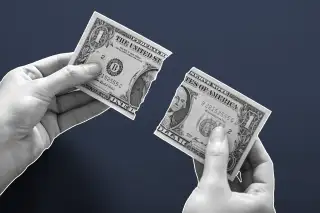Why It May Be Particularly Hard for You to Save Money This Year

If you made a New Year’s resolution to bulk up your savings account in 2022, you’re not alone. In a recent Fidelity survey, 43% of people considering a financial resolution said that saving more money was one of their goals.
Americans’ savings have soared over the last couple of years. The personal savings rate — the percentage of disposable income that Americans save each month — peaked at a staggering 33.8% in April 2020 because so many of the things we were accustomed to spending money on, like restaurants, entertainment, shopping, and vacations, were unavailable during the early days of the pandemic. Savings rates fell slightly as the economy reopened, but remained extremely high by historical standards for months.
As of November, that figure had fallen to 6.9%, its lowest level since December 2017. That’s because the landscape for savers is changing rapidly, and there’s a good chance that it will be even more difficult to save money in 2022.
Here are a few of the reasons why it may be harder to save this year:
High inflation
Consumer prices in the United States are rising at record rates thanks to an enormous surge in demand for goods alongside an ongoing global supply chain crisis, and the situation has only been worsened by a persistent labor shortage. In November, prices were 6.8% higher than the same time the previous year, with inflation in some categories, like meat and gasoline, significantly higher than that.
The Federal Reserve is expected to pull back on its support for the economy in the coming months to help prices stabilize again (more on that later), but the process will be slow.
In the meantime, be prepared to pay more in 2022 for everyday essentials like groceries, gas, clothing and even household heating costs and junk food like Oreos and Sour Patch Kids. And if you have to make a major purchase, like buying a car or home, be prepared for particularly high prices.
No more stimulus checks and relief money
Over the course of the last two years, Congress authorized three rounds of federal stimulus payments to help Americans weather the pandemic. Experts say the windfall from those payments — maxing out at $1,200, $600 and $1,400 per person — reduced debt loads, bolstered savings accounts and even helped lift families out of poverty.
As part of the American Rescue Plan in March (the same bill that authorized the third stimulus check), Congress authorized a major, though temporary, expansion of the Child Tax Credit (CTC) for 2021. The expansion increased the maximum value of the credit from $2,000 to $3,600 per child and allowed eligible parents to receive half of their credit in six monthly installments. The last advance child tax credit payment of 2021 hit parents’ bank accounts in December. A survey conducted by the Social Policy Institute at Washington University last summer found that nearly three-quarters of parents set to receive the credit anticipated using it to bolster their emergency savings.
The CTC isn’t going entirely away in 2022, but right now it is expected to revert back to $2,000, and parents won’t be receiving the money in advance monthly installments anymore. The Biden administration and some Congressional leaders have argued that the expanded credit payments should be continued through 2022, but no action has been taken. And while nothing is impossible, a fourth stimulus check is not likely.
As a result, many Americans likely won’t see those extra federal relief payments again in 2022, though eligible parents will still see the other half of their expanded CTC credit on the tax returns they file this year.
Student loan payments will likely resume
During the pandemic, the federal government put a freeze on student loan payments and interest accrual for federal borrowers. That freeze has been extended multiple times, most recently until May 1, 2022.
There’s no doubt that the suspension of payments was a boon for millions of borrowers. A survey conducted by Pew Charitable Trusts last summer found that 59% of borrowers who had stopped making payments during the pause had used the money mostly for essential expenses like food and rent. Interestingly, just 9% of respondents said the extra money had gone to savings.
Despite pressure from progressives and advocates for another extension of the freeze or permanent student loan forgiveness, right now it looks like borrowers should plan to start paying their loans again come spring.
Low interest rates for savers
In March 2020, the Federal Reserve slashed its benchmark interest rate to nearly zero in order to keep markets humming and prevent an economic meltdown. In the months that followed, banks across the country cut their own rates to remain competitive.
While interest rate cuts at banks are par for the course during economic downturns, they also mean that your money socked away in savings accounts earns a lot less than it did during boom times.
The sting of steep rate cuts was especially painful for customers at online banks like Marcus, Ally and Axos, which had wooed consumers with the promise of high-yield savings accounts that earned interest rates of 2% and above, compared to fractions of a percent at traditional banks. Now, rates for top high-yield savings accounts are hovering between 0.3% and 0.5%.
The Fed is expected to slowly start raising rates again this year, but it could take years for interest rates at consumer banks to tick back up again.
More from Money:
How Big Should Your 'Rainy Day' Savings Account Actually Be?